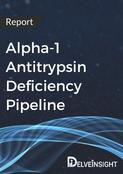Alpha-1 Antitrypsin Deficiency Pipeline
DelveInsight’s, “Alpha1-Antitrypsin Deficiency (AATD) Pipeline Insight, 2025,” report provides comprehensive insights about 12+ companies and 12+ pipeline drugs in Alpha1-Antitrypsin Deficiency (AATD) pipeline landscape. It covers the pipeline drug profiles, including clinical and nonclinical stage products. It also covers the therapeutics assessment by product type, stage, route of administration, and molecule type. It further highlights the inactive pipeline products in this space.
Geography Covered
- Global coverage
Alpha1-Antitrypsin Deficiency (AATD) Understanding
Alpha1-Antitrypsin Deficiency (AATD): Overview
Alpha-1-antitrypsin (AAT) is a protein produced in the liver that protects the body's tissues from being damaged by infection-fighting agents released by its immune system. In alpha-1 antitrypsin deficiency, the body’s normal production of AAT is reduced, resulting in the destruction of sensitive lung tissue. AAT deficiency is inherited. The severity of disease depends in part on the abnormalities present in the genes inherited from each parent. It is estimated that there are between 80,000 to 100,000 individuals affected by AAT deficiency in the United States.
Causes
AAT deficiency is an inherited condition. AAT deficiency happens when one or both parents pass on to their children an abnormal version of a gene that regulates the production of the AAT protein. Depending on the condition of the inherited genes, a person’s AAT levels may be normal, reduced or absent. When a person inherits an abnormal gene from each parent, it increases the severity of disease.
Not every individual with AAT deficiency develops emphysema, a type of COPD. People with AAT deficiency are at an increased risk of developing lung disease early in life if they smoke, are exposed to secondhand smoke, work or live in a dusty environment, have a family history of emphysema, have a personal history of asthma, or a history of repeated lung infections.
Symptoms
Symptoms can appear early in life, but many will not begin until a person reaches middle-age. Individuals with AAT deficiency have a wide variety of symptoms which may include:
- Shortness of breath
- Excessive cough with phlegm/sputum production
- Wheezing
- Decrease in exercise capacity and a persistent low energy state or tiredness
- Chest pain that increases when breathing in
Symptoms may be chronic or occur with acute respiratory tract infections, such as a cold or the flu.
When the liver is affected by AAT deficiency, symptoms may include tiredness, loss of appetite, weight loss, swelling of the feet or belly, yellowish discoloration of the skin (jaundice) or white part of the eyes, vomiting of blood, or blood in stools. In rare cases, AAT can cause a skin disease called panniculitis, resulting in hardened patches and red, painful lumps.
Diagnosis
Screening blood test to check the level of alpha-1 antitrypsin in the body. If the levels are low, genetic testing with another blood test may be used to identify any abnormal genes. Test for lung function or spirometry test, a chest X-ray or CT scan of the lungs, blood testing of liver function and in some cases an ultrasound of the liver. If patient has low levels of AAT but normal liver and lung function tests, the patient may not need treatment; however, can be monitored with repeat testing over time.
Treatment
There is no cure for AAT deficiency, but there are treatments to slow the lung damage it causes.
It may need a lifelong treatment called augmentation therapy. This treatment raises the levels of the AAT protein in the lungs, using ATT protein taken from the blood of donors. This helps slow down lung damage. Side effects of this treatment are rare and may include a mild fever, headaches, nausea, and dizziness.
If having COPD, the patient may need medicines or other treatments. Talk to the doctor about ways to help prevent or delay lung damage, such as quitting smoking and avoiding secondhand smoke, dust, or air pollution.
"Alpha-1 Antitrypsin Deficiency Pipeline Insight, 2025" report by DelveInsight outlays comprehensive insights of present scenario and growth prospects across the indication. A detailed picture of the Alpha-1 Antitrypsin Deficiency pipeline landscape is provided which includes the disease overview and Alpha-1 Antitrypsin Deficiency treatment guidelines. The assessment part of the report embraces, in depth Alpha-1 Antitrypsin Deficiency commercial assessment and clinical assessment of the pipeline products under development. In the report, detailed description of the drug is given which includes mechanism of action of the drug, clinical studies, NDA approvals (if any), and product development activities comprising the technology, Alpha-1 Antitrypsin Deficiency collaborations, licensing, mergers and acquisition, funding, designations and other product related details.
Report Highlights
The companies and academics are working to assess challenges and seek opportunities that could influence Alpha-1 Antitrypsin Deficiency R&D. The therapies under development are focused on novel approaches to treat/improve Alpha-1 Antitrypsin Deficiency.
Alpha-1 Antitrypsin Deficiency Emerging Drugs Chapters
This segment of the Alpha-1 Antitrypsin Deficiency report encloses its detailed analysis of various drugs in different stages of clinical development, including phase II, I, preclinical and Discovery. It also helps to understand clinical trial details, expressive pharmacological action, agreements and collaborations, and the latest news and press releases.
Alpha-1 Antitrypsin Deficiency Emerging Drugs
ARO AAT: Arrowhead Pharmaceuticals
ARO AAT is a second generation, N-Acetylgalactosamine (GalNAc) based, subcutaneously administered RNA interference based therapeutic. ARO-AAT is designed to knock down the hepatic production of the mutant alpha-1 antitrypsin (Z-AAT) protein, the cause of progressive liver disease in AATD patients. In June 2019, the US FDA has granted Fast Track designation to ARO-AAT. ARO-AAT is in Phase III clinical studies for the treatment of liver disease associated with alpha-1 antitrypsin deficiency (AATD).
ALN-AAT02: Alnylam Pharmaceuticals
ALN AAT02 is a subcutaneously administered RNAi therapeutic that targets alpha-1 antitrypsin (AAT). ALN-AAT02 is based on the Alnylam's enhanced stabilization chemistry plus (ESC+)-GalNAc-conjugate technology, which enables subsequent subcutaneous dosing with increased selectivity and a wide therapeutic index. The drug is currently in Phase I/II clinical development for the treatment of ZZ Type AAT Deficiency Liver Disease.
Further product details are provided in the report……..
Alpha-1 Antitrypsin Deficiency: Therapeutic Assessment
This segment of the report provides insights about the different Alpha-1 Antitrypsin Deficiency drugs segregated based on following parameters that define the scope of the report, such as:
Stay ahead with in-depth analysis of the Alpha-1 Antitrypsin Deficiency Market Foreacst-discover emerging therapies, epidemiology data and growth opportunities.
Major Players in Alpha-1 Antitrypsin Deficiency
There are approx. 12+ key companies which are developing the therapies for Alpha-1 Antitrypsin Deficiency. The companies which have their Alpha-1 Antitrypsin Deficiency drug candidates in the most advanced stage, i.e. phase III include, Deerland Probiotics & Enzymes.
Phases
DelveInsight’s report covers around 12+ products under different phases of clinical development like
- Late stage products (Phase III)
- Mid-stage products (Phase II)
- Early-stage product (Phase I) along with the details of
- Pre-clinical and Discovery stage candidates
- Discontinued & Inactive candidates
Route of Administration
Alpha-1 Antitrypsin Deficiency pipeline report provides the therapeutic assessment of the pipeline drugs by the Route of Administration. Products have been categorized under various ROAs such as
- Intra-articular
- Intraocular
- Intrathecal
- Intravenous
- Ophthalmic
- Oral
- Parenteral
- Subcutaneous
- Topical
- Transdermal
Molecule Type
Products have been categorized under various Molecule types such as
- Oligonucleotide
- Peptide
- Small molecule
Product Type
Drugs have been categorized under various product types like Mono, Combination and Mono/Combination.
Alpha1-Antitrypsin Deficiency (AATD): Pipeline Development Activities
The report provides insights into different therapeutic candidates in phase III, II, I, preclinical and discovery stage. It also analyses Alpha1-Antitrypsin Deficiency (AATD) therapeutic drugs key players involved in developing key drugs.
Pipeline Development Activities
The report covers the detailed information of collaborations, acquisition and merger, licensing along with a thorough therapeutic assessment of emerging Alpha1-Antitrypsin Deficiency (AATD) drugs.
Alpha1-Antitrypsin Deficiency (AATD) Report Insights
- Alpha1-Antitrypsin Deficiency (AATD) Pipeline Analysis
- Therapeutic Assessment
- Unmet Needs
- Impact of Drugs
Alpha1-Antitrypsin Deficiency (AATD) Report Assessment
- Pipeline Product Profiles
- Therapeutic Assessment
- Pipeline Assessment
- Inactive drugs assessment
- Unmet Needs
Key Questions
Current Treatment Scenario and Emerging Therapies:
- How many companies are developing Alpha1-Antitrypsin Deficiency (AATD) drugs?
- How many Alpha1-Antitrypsin Deficiency (AATD) drugs are developed by each company?
- How many emerging drugs are in mid-stage, and late-stage of development for the treatment of Alpha1-Antitrypsin Deficiency (AATD)?
- What are the key collaborations (Industry–Industry, Industry–Academia), Mergers and acquisitions, licensing activities related to the Alpha1-Antitrypsin Deficiency (AATD) therapeutics?
- What are the recent trends, drug types and novel technologies developed to overcome the limitation of existing therapies?
- What are the clinical studies going on for Alpha1-Antitrypsin Deficiency (AATD) and their status?
- What are the key designations that have been granted to the emerging drugs?

